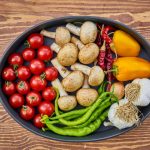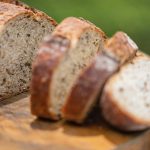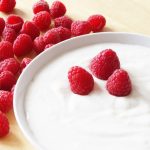When it comes to eating a variety of foods and maintaining balance within your diet, MyPlate is an essential tool that can help you transform your meals and snacks. The USDA published MyPlate, which outlines the 5 major food groups, with each category offering its own nutrition recommendations.
 We’ll break down each food group together and review the major nutrition messages that can help you be successful when choosing the most nutritious foods for you and your family.
We’ll break down each food group together and review the major nutrition messages that can help you be successful when choosing the most nutritious foods for you and your family.
Fruit
 First we’ll start with the fruit group, which is labeled in red. As you can see this food group makes up just less than 1/4 of your plate. The big message here is that the fruit group pairs right next to the vegetable group, filling half your plate with fruits and vegetables. We all know that fruits are healthy for us, but specifically this food group is a major powerhouse of vitamins, minerals, and fiber. Keep in mind these helpful tips when choosing fruits in your meals and snacks:
First we’ll start with the fruit group, which is labeled in red. As you can see this food group makes up just less than 1/4 of your plate. The big message here is that the fruit group pairs right next to the vegetable group, filling half your plate with fruits and vegetables. We all know that fruits are healthy for us, but specifically this food group is a major powerhouse of vitamins, minerals, and fiber. Keep in mind these helpful tips when choosing fruits in your meals and snacks:
- Choose whole fruits most often
For example, if you have the option, choose a whole peach over canned peaches in syrup or pick a fresh apple instead of sweetened applesauce.
- Make half of your plate fruits and vegetables
This key message is shared with the vegetable group. To maximize the vitamins and minerals in your meal or snack, ensure that half of your plate is filled with fruits and vegetables. For example, you may have an orange on the side of your leftover vegetable casserole or you may have a peanut butter and banana sandwich with a side of baby carrots for lunch. Whatever the meal may be, check in to see if you’ve included fruits and vegetables as half of the meal.
Vegetables
 Next up is the vegetable group! This green group in the MyPlate image fills up slightly more than 1/4 of the plate. This is another rock star nutrition category loaded with vitamins, minerals, and fiber. Keep in mind these helpful tips when choosing vegetables in your meals and snacks:
Next up is the vegetable group! This green group in the MyPlate image fills up slightly more than 1/4 of the plate. This is another rock star nutrition category loaded with vitamins, minerals, and fiber. Keep in mind these helpful tips when choosing vegetables in your meals and snacks:
- Choose whole vegetables most often
Just like the fruit group, choose the least processed vegetables as possible. For example, choose fresh or frozen plain broccoli in place of frozen cheesy broccoli. Another idea would be to choose a baked potato on the side of your meal instead of potato chips.
- Make half of your plate fruits and vegetables
Just like the fruit category, check in to see if half of your plate is filled with fruits and vegetables. Vegetables can be a separate item on your plate, intertwined in a casserole, layered in a sandwich, or be the basis of your snack. Add vegetables to stir fry, pasta, sandwiches and wraps, muffins, or as a side dish.
Grains
 Grains seem to be a hot topic today, but this is an important food group we shouldn’t discount. Grain foods are loaded with carbohydrates that fuel the body with energy. Check out the following tips to help you choose the most nutritious grains:
Grains seem to be a hot topic today, but this is an important food group we shouldn’t discount. Grain foods are loaded with carbohydrates that fuel the body with energy. Check out the following tips to help you choose the most nutritious grains:
- Make half of your grains whole grains
What’s a whole grain? A whole grain is a grain that contains all 3 parts of the grain (the germ, endosperm, and bran). Whole grains are less refined and processed, so they typically offer more fiber and protein. Grains such as 100% whole wheat bread are considered to be a whole grain, while white wheat bread is an example of a non-whole grain food. Just a few examples of other whole grains include quinoa, 100% whole wheat pasta, farro, barley, brown rice, kamut, bulgur, popcorn, and oatmeal.
- Have grain foods make up about 1/4 of your plate
Looking at the MyPlate image really helps us to see the amount of grains we need in comparison to the other food groups. Keep this in mind when you’re meal prepping or following your Nuleeu meal plan.
Protein
 Protein foods are important not only for the protein they deliver, but the additional nutrients loaded in the variety of foods in this category. Protein foods not only include meat, poultry, and fish, but also nuts, soy, seeds, eggs, and beans. Keep in mind these helpful tips when choosing protein foods in your meals and snacks:
Protein foods are important not only for the protein they deliver, but the additional nutrients loaded in the variety of foods in this category. Protein foods not only include meat, poultry, and fish, but also nuts, soy, seeds, eggs, and beans. Keep in mind these helpful tips when choosing protein foods in your meals and snacks:
- Choose lean proteins
Vary your lean proteins by choosing items such as beans, tofu, at least 92% lean beef, and skinless poultry.
- Choose low sodium protein foods
When you’re meal planning for example, choose whole turkey breasts in place of deli turkey slices or choose unsalted nuts instead of salted varieties to limit the sodium content of your food.
- Have protein foods make up just less than 1/4 of your plate
Protein foods only need to fill about 1/4 of your plate. This will come as a surprise to many of us since we usually have our protein at the center of our plate in the largest portion. Surprisingly, your current protein portions may be enough protein for you all day! Keep in mind that nutritional needs vary from person to person and a Nuleeu Registered Dietitian can meet with you to review your specific needs and make individual recommendations and meal plans just for you.
Dairy
D airy foods are incorporated in our meals and snacks to help us meet a variety of our vitamin and mineral needs. Dairy foods include cow’s milk, yogurt, and cheese, but also non-dairy fortified beverages and foods such as soy or almond milks and yogurts. All of these products can offer important minerals such a calcium and phosphorus for bone health, while other dairy foods provide protein and other vitamins and minerals. Check out the following tip to help you choose the most nutritious dairy foods:
airy foods are incorporated in our meals and snacks to help us meet a variety of our vitamin and mineral needs. Dairy foods include cow’s milk, yogurt, and cheese, but also non-dairy fortified beverages and foods such as soy or almond milks and yogurts. All of these products can offer important minerals such a calcium and phosphorus for bone health, while other dairy foods provide protein and other vitamins and minerals. Check out the following tip to help you choose the most nutritious dairy foods:
- Choose low fat dairy products
When we incorporate dairy foods, we want to choose fat free or low fat products most often to help limit the amount of saturated fat in the food. Plant-based alternative products are a great nutrient-rich alternative to dairy products, but be sure to check the saturated fat content of these products as well. For example, many coconut yogurts contain a high amount of saturated fat.
There you have it! That completes our tour through the 5 food groups of MyPlate and the many nutrition messages this guide offers. MyPlate is excellent because it can be used and applied to not only meals, but also snacks. Although the MyPlate image depicts separation between foods on the plate, this guide can be applied to complex mixed dishes, sandwiches, smoothies, and snacks. How have you incorporated MyPlate into your meals and snacks? We’d love to hear from you!
-Elizabeth Fay, MS, RDN, CNSC
References:
- All about the Dairy Group.” Choose MyPlate, USDA, 14 Dec. 2018, www.choosemyplate.gov/dairy
- All About the Fruit Group.” Choose MyPlate, USDA, 4 Jan. 2018, www.choosemyplate.gov/fruit
- All about the Grains Group.” Choose MyPlate, USDA, 3 Nov. 2017, www.choosemyplate.gov/grains
- All about the Protein Foods Group.” Choose MyPlate, USDA, 10 Aug. 2018, www.choosemyplate.gov/protein-foods
- All about the Vegetable Group.” Choose MyPlate, USDA, 4 Jan. 2018, www.choosemyplate.gov/vegetables
- MyPlate Graphic Resources.” Choose MyPlate, USDA, 3 Dec. 2018, www.choosemyplate.gov/myplate-graphic-resources

